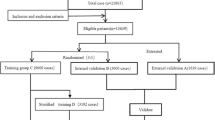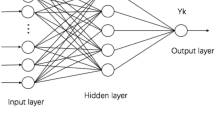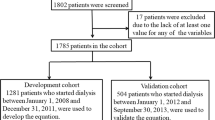Abstract
Background
Tailoring warfarin use poses a challenge for physicians and pharmacists due to its narrow therapeutic window and substantial inter-individual variability. This study aimed to create an adapted neural-fuzzy inference system (ANFIS) model using preprocessed balance data to improve the predictive accuracy of warfarin maintenance dosing in Chinese patients undergoing heart valve replacement (HVR).
Methods
This retrospective study enrolled patients who underwent HVR between June 1, 2012, and June 1, 2016, from 35 centers in China. The primary outcomes were the mean difference between predicted warfarin dose by ANFIS models and actual dose and the models’ predictive accuracy, including the ideal predicted percentage, the mean absolute error (MAE), and the mean squared error (MSE). The eligible cases were divided into training, internal validation, and external validation groups. We explored input variables by univariate analysis of a general linear model and created two ANFIS models using imbalanced and balanced training sets. We finally compared the primary outcomes between the imbalanced and balanced ANFIS models in both internal and external validation sets. Stratified analyses were conducted across warfarin doses (low, medium, and high doses).
Results
A total of 15,108 patients were included and grouped as follows: 12,086 in the imbalanced training set; 2820 in the balanced training set; 1511 in the internal validation set; and 1511 in the external validation set. Eight variables were explored as predictors related to warfarin maintenance doses, and imbalanced and balanced ANFIS models with multi-fuzzy rules were developed. The results showed a low mean difference between predicted and actual doses (< 0.3 mg/d for each model) and an accurate prediction property in both the imbalanced model (ideal prediction percentage, 74.39–78.16%; MAE, 0.37 mg/daily; MSE, 0.39 mg/daily) and the balanced model (ideal prediction percentage, 73.46–75.31%; MAE, 0.42 mg/daily; MSE, 0.43 mg/daily). Compared to the imbalanced model, the balanced model had a significantly higher prediction accuracy in the low-dose (14.46% vs. 3.01%; P < 0.001) and the high-dose warfarin groups (34.71% vs. 23.14%; P = 0.047). The results from the external validation cohort confirmed this finding.
Conclusions
The ANFIS model can accurately predict the warfarin maintenance dose in patients after HVR. Through data preprocessing, the balanced model contributed to improved prediction ability in the low- and high-dose warfarin groups.




Similar content being viewed by others
Data Availability
All data can be obtained by contacting the corresponding author.
References
Kirley K, Qato DM, Kornfield R, Stafford RS, Alexander GC. National trends in oral anticoagulant use in the United States, 2007 to 2011. Circulation-Cardiov Qual Outcomes. 2012;5(5):615–21.
Anderson JL, Horne BD, Stevens SM, Grove AS, Barton S, Nicholas ZP, et al. Randomized trial of genotype-guided versus standard warfarin dosing in patients initiating oral anticoagulation. Circulation. 2007;116(22):2563–70.
Sconce EA, Khan TI, Wynne HA, Avery P, Monkhouse L, King BP, et al. The impact of CYP2C9 and VKORC1 genetic polymorphism and patient characteristics upon warfarin dose requirements: proposal for a new dosing regimen. Blood. 2005;106(7):2329–33.
Jorgensen AL, Pirmohamed M. Risk modeling strategies for pharmacogenetic studies. Pharmacogenomics. 2011;12(3):397–410.
Yan H, Yin J-Y, Zhang W, Li X. Possible strategies to make warfarin dosing algorithm prediction more accurately in patients with extreme dose. Clin Pharmacol Therap. 2018;103(2):184.
Klein TE, Altman RB, Eriksson N, Gage BF, Kimmel SE, Lee MTM, et al. Estimation of the warfarin dose with clinical and pharmacogenetic data (vol 360, pg 753, 2009). N Engl J Med. 2009;361(16):1613.
Gage BF, Eby C, Johnson JA, Deych E, Rieder MJ, Ridker PM, et al. Use of pharmacogenetic and clinical factors to predict the therapeutic dose of warfarin. Clinical Pharmacol Therap. 2008;84(3):326–31.
Anderson JL, Horne BD, Stevens SM, Woller SC, Samuelson KM, Mansfield JW, et al. A randomized and clinical effectiveness trial comparing two pharmacogenetic algorithms and standard care for individualizing warfarin dosing (CoumaGen-II). Circulation. 2012;125(16):1997.
Li X, Liu R, Luo Z-Y, Yan H, Huang W-H, Yin J-Y, et al. Comparison of the predictive abilities of pharmacogenetics-based warfarin dosing algorithms using seven mathematical models in Chinese patients. Pharmacogenomics. 2015;16(6):583–90.
Tao H, Li Q, Zhou Q, Chen J, Fu B, Wang J, et al. A prediction study of warfarin individual stable dose after mechanical heart valve replacement: adaptive neural-fuzzy inference system prediction. BMC Surg. 2018;18:10.
Zhou Q, Kwong J, Chen J, Qin W, Chen J, Dong L, et al. Use of artificial neural network to predict warfarin individualized dosage regime in Chinese patients receiving low-intensity anticoagulation after heart valve replacement. Int J Cardiol. 2014;176(3):1462–4.
Li Q, Tao H, Wang J, Zhou Q, Chen J, Qin WZ, et al. Warfarin maintenance dose prediction for patients undergoing heart valve replacement-a hybrid model with genetic algorithm and back-propagation neural network. Sci Rep. 2018;8:9712.
Li Q, Wang J, Tao H, Zhou Q, Chen J, Fu B, et al. The prediction model of warfarin individual maintenance dose for patients undergoing heart valve replacement, based on the back propagation neural network. Clin Drug Investig. 2020;40(1):41–53.
Groszek B, Piszczek P. Vitamin K antagonists overdose. Przegl Lek. 2015;72(9):468–71.
Heffler E, Campisi R, Ferri S, Crimi N. A bloody mess: an unusual case of diffuse alveolar hemorrhage because of warfarin overdose. Am J Ther. 2016;23(5):E1280–E3.
Levine M, Pizon AF, Padilla-Jones A, Ruha A-M. Warfarin overdose: a 25-year experience. J Med Toxicol. 2014;10(2):156–64.
Wang SV, Franklin JM, Glynn RJ, Schneeweiss S, Eddings W, Gagne JJ. Prediction of rates of thromboembolic and major bleeding outcomes with dabigatran or warfarin among patients with atrial fibrillation: new initiator cohort study. Bmj-British Med J. 2016;353. https://doi.org/10.1136/bmj.i2607.
Zhang Y, Liu B, Cai J, Zhang S. Ensemble weighted extreme learning machine for imbalanced data classification based on differential evolution. Neural Comput Applic. 2017;28:S259–67.
Jang JR, Sun CT. Functional equivalence between radial basis function networks and fuzzy inference systems. IEEE Trans Neural Netw. 1993;4(1):156–9.
Gage BF, Eby C, Milligan PE, Banet GA, Duncan JR, McLeod HL. Use of pharmacogenetics and clinical factors to predict the maintenance dose of warfarin. Thromb Haemost. 2004;91(1):87–94.
Aquilante CL, Langaee TY, Lopez LM, Yarandi HN, Tromberg JS, Mohuczy D, et al. Influence of coagulation factor, vitamin K epoxide reductase complex subunit 1, and cytochrome P4502C9 gene polymorphisms on warfarin dose requirements. Clinical Pharmacol Therap. 2006;79(4):291–302.
Herman D, Peternel P, Stegnar M, Breskvar K, Dolzan V. The influence of sequence variations in factor VII, gamma-glutamyl carboxylase and vitamin K epoxide reductase complex genes on warfarin dose requirement. Thromb Haemost. 2006;95(5):782–7.
Wadelius M, Chen LY, Eriksson N, Bumpstead S, Ghori J, Wadelius C, et al. Association of warfarin dose with genes involved in its action and metabolism. Hum Genet. 2007;121(1):23–34.
Zhu Y, Shennan M, Reynolds KK, Johnson NA, Herrnberger MR, Valdes R Jr, et al. Estimation of warfarin maintenance dose based on VKORCI (-1639 G > A) and CYP2C9 genotypes. Clin Chem. 2007;53(7):1199–205.
Miao L, Yang J, Huang C, Shen Z. Contribution of age, body weight, and CYP2C9 and VKORC1 genotype to the anticoagulant response to warfarin: proposal for a new dosing regimen in Chinese patients. Eur J Clin Pharmacol. 2007;63(12):1135–41.
Wen MS, Lee MTM, Chen JJ, Chuang HP, Lu LS, Chen CH, et al. Prospective study of warfarin dosage requirements based on CYP2C9 and VKORC1 genotypes. Clinical Pharmacol Therap. 2008;84(1):83–9.
Huang S-W, Chen H-S, Wang X-Q, Huang L, Xu D-L, Hu X-J, et al. Validation of VKORC1 and CYP2C9 genotypes on interindividual warfarin maintenance dose: a prospective study in Chinese patients. Pharmacogenet Genomics. 2009;19(3):226–34.
Cen H-J, Zeng W-T, Leng X-Y, Huang M, Chen X, Li J-L, et al. CYP4F2 rs2108622: a minor significant genetic factor of warfarin dose in Han Chinese patients with mechanical heart valve replacement. Br J Clin Pharmacol. 2010;70(2):234–40.
You JHS, Wong RSM, Waye MMY, Mu Y, Lim CK. Choi K-c et al. Warfarin dosing algorithm using clinical, demographic and pharmacogenetic data from Chinese patients. J Thromb Thrombolysis. 2011;31(1):113–8.
Wei M, Ye F, Xie D, Zhu Y, Zhu J, Tao Y, et al. A new algorithm to predict warfarin dose from polymorphisms of CYP4F2, CYP2C9 and VKORC1 and clinical variables: derivation in Han Chinese patients with non valvular atrial fibrillation. Thromb Haemost. 2012;107(6):1083–91.
Lou Y, Liu H, Han L, Xie S, Huang YL, Li YS. The study of warfarin maintenance dose algorithm in Chinese Han population. Int J Cardiol. 2013;163:S9.
Liu R, Li X, Zhang W, Zhou HH. Comparison of nine statistical model based warfarin pharmacogenetic dosing algorithms using the racially diverse international warfarin pharmacogenetic consortium cohort database. PLoS One. 2015;10(8):e0135784.
Tao Y, Chen YJ, Fu X, Jiang B, Zhang Y. Evolutionary ensemble learning algorithm to modeling of warfarin dose prediction for Chinese. IEEE J Biomed Health Inform. 2019;23(1):395–406.
Tao Y, Chen YJ, Xue L, Xie C, Jiang B, Zhang Y. An ensemble model with clustering assumption for warfarin dose prediction in Chinese patients. IEEE J Biomed Health Inform. 2019;23(6):2642–54.
Li S, Garcia DA, Khorana AA, Carrier M, Lyman GH, Kalmanti L, et al. Treatment of vascular thrombosis in antiphospholipid syndrome: an update. Cancer. 2020;40(1):31–7.
He H, Garcia EA. Learning from imbalanced data. IEEE Trans Knowl Data Eng. 2009;21(9):1263–84.
Hirzel A, Guisan A. Which is the optimal sampling strategy for habitat suitability modelling. Ecol Model. 2002;157(2-3):331–41.
Funding
This study was supported by the National Natural Science Foundation of China (71974137 and 81641021), research funds of Shanghai Health and Family Planning commission (20184Y0022), cultivation fund of clinical research of Renji Hospital (PY2018-III-06), Clinical Pharmacy Innovation Research Institute of Shanghai Jiao Tong University School of Medicine (CXYJY2019ZD001), and Shanghai “Rising Stars of Medical Talent” Youth Development Program — Youth Medical Talents — Clinical Pharmacist Program (SHWJRS (2019)_072).
Author information
Authors and Affiliations
Contributions
Chen is the guarantor of the entire manuscript. Gu and Huang contributed to the study conception and design, critical revision of the manuscript for important intellectual content, and final approval of the published version. Li, Zhou, Wang, and Fu contributed to data acquisition, analysis, and interpretation.
Corresponding author
Ethics declarations
Ethical Statement
This study was registered in the Chinese Clinical Trial Register platform (trial number, ChiCTR-OCH-10001185). The study protocol was approved by the Ethics Committee of West China Hospital of Sichuan University (ChiECRCT-201792). All participants signed written informed consent.
Conflicts of Interest
The authors declare no competing interests.
Additional information
Publisher’s Note
Springer Nature remains neutral with regard to jurisdictional claims in published maps and institutional affiliations.
Supplementary Information
ESM 1
(DOC 718 kb)
Rights and permissions
About this article
Cite this article
Gu, ZC., Huang, SR., Dong, L. et al. An Adapted Neural-Fuzzy Inference System Model Using Preprocessed Balance Data to Improve the Predictive Accuracy of Warfarin Maintenance Dosing in Patients After Heart Valve Replacement. Cardiovasc Drugs Ther 36, 879–889 (2022). https://doi.org/10.1007/s10557-021-07191-1
Accepted:
Published:
Issue Date:
DOI: https://doi.org/10.1007/s10557-021-07191-1




